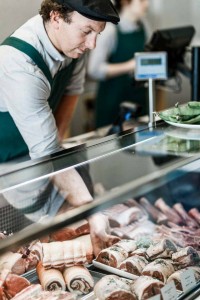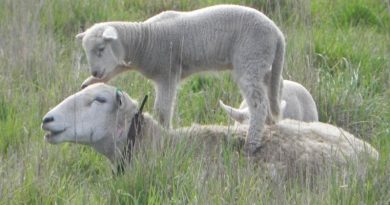Frequently Asked Questions – Moffitts Farm
SIZE AND LOCATION
Moffitts is a 50 ha farm in the Macedon Ranges shire, near the town of Romsey. It is 60km from Melbourne, Victoria, Australia.
OUR LIVESTOCK
We have 80 breeding ewes that lamb in spring each year. The sheep are Wiltipolls, a breed that sheds its wool each spring, therefore requiring no shearing. People do not use the wool of Wiltipolls, but we often find bird’s nests lined with it. We have two Wiltipoll rams and one Wiltipoll-Dorper cross ram for a genetics comparison trial. We are keeping performance records(fertility and growth rates) of our stock and aim to purchase rams with known Australian Sheep Breeding Values. (Australian Sheep Breeding Values are an estimate of an animal’s true genetic value based on its pedigree and performance records that are adjusted to take into account environmental factors influence genetic traits).
Learn more: Our farm – the basics – sheep. Our farm – the basics – animal welfare.
OUR PRODUCTS
We sell our meat at Meatsmith, 273 Smith St, Fitzroy. We produce a high quality meat which won a silver medal at the 2015 Royal Melbourne Fine Food Awards.
We also sell Moffitts Farm Wiltipoll Lawnmowing sheep. Find out more here and through this factsheet.
WHAT TYPE OF FARMING IS PRACTICED?
We call our farming method Comfortable Farming. Some would call it holistic grazing or regenerative farming as it embraces those principles while looking after the environment, the livestock and us as owners. We are not certified organic, although our practices are consistent with organic farming methods which are based on using natural inputs rather than chemical ones. We do not want to align ourselves to one particular farming style as we contend all can contribute to regenerative agriculture if practiced with knowledge and respect for the environment, livestock performance and welfare. We are interested in farming ethically and improving our farm’s ecosystem services, using science to inform our decisions. We love trialing new or different approaches to farming. If you come to our farm workshops you can learn about why the system works, what you need to test and monitor on your own farm, and see soil test, individual paddock livestock carrying capacity, pasture persistence, and livestock health data from Moffitts Farm. We are particularly concerned about livestock welfare and embrace low stress livestock handling (our sheep follow and are not herded), optimum animal nutrition year round and protecting new born lambs from exposure to inclement weather. The latter is achieved by ensuring large quantities of pasture are present in all paddocks so the lambs always have protection from cold wind.
Learn more: Our farm – the basics – comfortable farming. Also find out more about Workshops
PASTURE SPECIES
A critical component of Comfortable Farming involves ensuring the right species are present across the 80% farm land covered in pasture. We have deliberately chosen to include perennial pasture grasses, forbs and legumes which grow over summer as well as the rest of the year. These are called “evergreen” or “summer active species”. Most species of perennial grasses have varieties which are evergreen and varieties which are summer dormant. The evergreen species we particular like are cocksfoot, tall fescue, chicory, strawberry clover and lucerne. But we also like summer dormant species such as perennial ryegrass, phalaris, and sub clover. Species diversity is our goal and our grazing management incorporating long rest periods means some indigenous species, Wallaby Grass and Microlaena, unseen in the past are spreading in the pasture.
Our choice of pasture species and their grazing management not only ensures year round food for livestock, but also has direct connections to improvements in animal welfare, farm biodiversity, soil health, water quality and CO2 sequestration. The impact of pasture on animal welfare is rarely understood in conventional farming circles but we can show how high herbage mass pastures provides ewes giving birth with the ultimate “birthing area” that incorporates excellent nutrition for the ewe during the critical 8 hours pre and post lambing, and protection for the lambs against cold chill. Our data shows wind speed is reduced to zero behind the high herbage mass perennial grass tussocks covering the lambing and post lambing paddocks.d
Learn more: Our farm’s pastures and grazing
BIODIVERSITY and HABITAT
We have planted more than 10,000 trees and shrubs on the property, including two hectares of habitat corridors along the creek and fencelines. Included in the species mix is manna gums – planted specifically to encourage koalas into the farm land adjacent to the Macedon Ranges. In total 20% of the farm area comprises conservation corridors and forestry blocks. We have not taken any funding to build our fencelines or plant the areas out, however we have had off-farm sources of income to support our farm’s development. See some of our biodiversity photos on the Bowerbird website.
Learn more: Our farm – the basics – conservation.
TREE SPECIES
The 20% of Moffitts Farm devoted to conservation corridors and forestry has been planted with trees and shrubs starting as tubestock and or seed via direct seeding. The latter involves up to 30 different species depending on the availability at the time. With tubestock for forestry we planted Tasmanian Blue Gum, Sydney Blue Gum, Shining Gum, Spotted Gum and Sugar Gum. Tubestock for conservation have been mainly River Sheoak, Manna Gum and Blackwood. After trialing many different methods of planting conservation corridors since 1986 our preferred method is four rows, two of tubestock and two of direct seeding 4 metres apart in a 30 metre wide fenced off corridor. This corridor provides useful weather protection to livestock, has a wide range of species to enhance biodiversity, but also has species for future high value timber if individual trees are pruned. The wide spacing between rows enables space for grass management such as slashing and tree pruning.
The net impact of Moffitts Farm conservation and forestry planting on our greenhouse gas balance has been massive. The farm is currently a net greenhouse gas sink to the tune of 250 tonnes CO2 equivalent per year
OUR FARM FOREST
We have 6ha of Tasmanian bluegum, 1ha Sydney bluegum and 1 ha sugar gum. In all, around 8000 forestry tubestock have been planted since 1986. We have pruned many of the trees with straight trunks and aim to let them grow for 40 – 50 years then have them harvested as sawn timber for housing construction and even furniture and floor boards. In the meantime smaller trees are harvested for on-farm use such as fence posts and fire wood. We would like most of our forestry thinnings (approximately 6000 trees) to be used as a source of renewable biofuel for use in small scale local boilers to generate heat and electricity. Unfortunately such an outlet is not available in Victoria as successive government policy has not embraced this approach to renewable energy. In the meantime we are on the lookout for fire wood processors who would like to purchase a renewable source of raw material (contact francis@ozonline.com.au for more information about this opportunity).
WEEDS AND PESTS
In our district foxes and rabbits are the main pests, and weed threats include blackberry, gorse, hawthorn and spear thistles. A range of control methods are implemented each year so pests and weeds are kept under control. We cannot eradicate them as pests and weeds are constantly re-introduced via wind, water and wild animals.
Eastern grey kangaroos can be a problem as they find our pastures more attractive than on neighboring farms because of the habitat surrounding the paddocks and the quantity of green feed present.
HOUSE AND GARDEN
We have no mains power or water, so we have installed solar panels and rainwater tanks. We keep chickens and have an orchard and vegie patches. Our weather board cottage and out buildings date back to original settlers and were built in the 1880’s. It has been minimally renovated to allow more light in and insulated. We enjoy knowing that the house and sheds were built from timber which started life as seedlings around two hundred years ago. The carbon in those trees accumulated over decades as they grew and is still held in building timber. It reminds us of the importance of renewable forestry as a constant source of carbon capture and storage.





